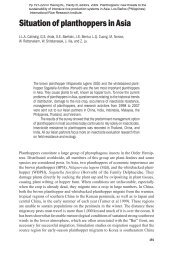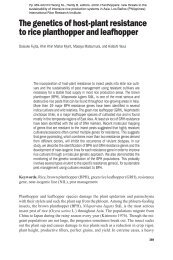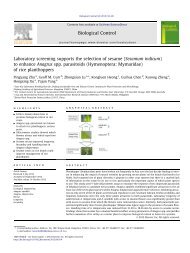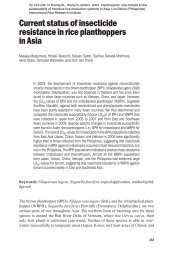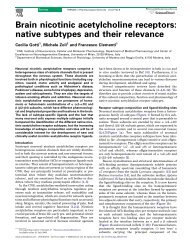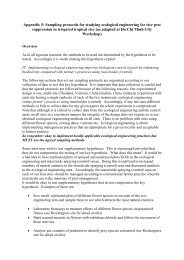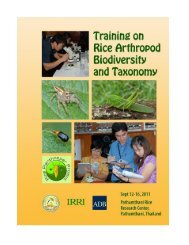Chen, Yolanda et al. 2011. Planthopper âadaptationâ - Ricehoppers
Chen, Yolanda et al. 2011. Planthopper âadaptationâ - Ricehoppers
Chen, Yolanda et al. 2011. Planthopper âadaptationâ - Ricehoppers
Create successful ePaper yourself
Turn your PDF publications into a flip-book with our unique Google optimized e-Paper software.
Author's person<strong>al</strong> copy<br />
Journ<strong>al</strong> of Insect Physiology 57 (2011) 1375–1384<br />
Contents lists available at ScienceDirect<br />
Journ<strong>al</strong> of Insect Physiology<br />
journ<strong>al</strong> homepage: www.elsevier.com/locate/jinsphys<br />
<strong>Planthopper</strong> ‘‘adaptation’’ to resistant rice vari<strong>et</strong>ies: Changes in amino acid<br />
composition over time<br />
<strong>Yolanda</strong> H. <strong>Chen</strong> a,c,⇑ , Carmencita C. Bern<strong>al</strong> a , Jing Tan b , Finbarr G. Horgan a , Melissa A. Fitzger<strong>al</strong>d b<br />
a Division of Crop and Environment<strong>al</strong> Sciences, Internation<strong>al</strong> Rice Research Institute, Los Baños, Laguna, Philippines<br />
b Grain Qu<strong>al</strong>ity, Nutrition, and Postharvest Center, Internation<strong>al</strong> Rice Research Institute, Los Baños, Laguna, Philippines<br />
c Department of Plant and Soil Sciences, University of Vermont, 63 Carrigan Drive, Burlington, VT, USA<br />
article<br />
info<br />
abstract<br />
Article history:<br />
Received 10 February 2011<br />
Received in revised form 24 June 2011<br />
Accepted 5 July 2011<br />
Available online 18 July 2011<br />
Keywords:<br />
Amino acid<br />
M<strong>et</strong>abolism<br />
Endosymbionts<br />
Host plant resistance<br />
Adaptation<br />
Virulence<br />
The brown planthopper, Nilaparvata lugens, shows considerable geographic and tempor<strong>al</strong> variability in its<br />
response to vari<strong>et</strong>ies of cultivated rice. N. lugens has repeatedly ‘‘adapted’’ to resistant rice vari<strong>et</strong>ies; however,<br />
the physiologic<strong>al</strong> changes underlying planthopper adaptation are poorly understood. Endosymbionts<br />
within planthoppers, such as yeast-like endosymbionts (YLS) could play a role as they<br />
produce essenti<strong>al</strong> amino acids for planthoppers. We used a full factori<strong>al</strong> study to d<strong>et</strong>ermine how nat<strong>al</strong><br />
rice vari<strong>et</strong>y, exposed rice vari<strong>et</strong>y, YLS presence, and the number of reared generations affected nymph<strong>al</strong><br />
development, planthopper tot<strong>al</strong> nitrogen content, and planthopper hydrolyzed amino acid profiles. Nymph<strong>al</strong><br />
development was strongly influenced by a four-way interaction b<strong>et</strong>ween the exposed rice vari<strong>et</strong>y,<br />
nat<strong>al</strong> rice vari<strong>et</strong>y, number of reared generations, and YLS presence. While symbiosis improved nymph<strong>al</strong><br />
performance in the 8th generation, it appeared to be a drain on nymphs in the 11th generation, when the<br />
aposymbiotic nymphs actu<strong>al</strong>ly showed higher performance than the symbiotic nymphs. This suggests<br />
that the symbiotic relationship may be acting benefici<strong>al</strong>ly in one generation while acting as a drain during<br />
another generation. Aposymbiotic planthoppers reared for 11 generations had a higher proportion<strong>al</strong><br />
concentration of rare amino acids than those reared for 8 generations, indicating that the planthopper<br />
itself appears to improve its ability to acquire rare amino acids. Therefore, the change in amino acid composition<br />
of planthoppers suggests an underlying change in protein expression or amino acid m<strong>et</strong>abolism<br />
over time.<br />
Ó 2011 Elsevier Ltd. All rights reserved.<br />
1. Introduction<br />
The brown planthopper, Nilaparvata lugens Stål (Hemiptera:<br />
Delphacidae), shows considerable geographic and tempor<strong>al</strong> variability<br />
in its response to cultivated rice vari<strong>et</strong>ies (Heinrichs <strong>et</strong> <strong>al</strong>.,<br />
1985; Pathak and Khush, 1979; Pathak and Heinrichs, 1982). As a<br />
product of the Green Revolution (Kenmore <strong>et</strong> <strong>al</strong>., 1984), N. lugens<br />
outbreaks have threatened rice production and food security (Cohen<br />
<strong>et</strong> <strong>al</strong>., 1997; Dyck and Thomas, 1979). Although there has been<br />
significant investment in breeding for rice resistance to the brown<br />
planthopper in Asia (Cha <strong>et</strong> <strong>al</strong>., 2008; Cohen <strong>et</strong> <strong>al</strong>., 1997; Heinrichs<br />
<strong>et</strong> <strong>al</strong>., 1985; Jairin <strong>et</strong> <strong>al</strong>., 2007; Jena <strong>et</strong> <strong>al</strong>., 2006; Lu <strong>et</strong> <strong>al</strong>., 2007; Park<br />
<strong>et</strong> <strong>al</strong>., 2007; Su <strong>et</strong> <strong>al</strong>., 2006; Sun <strong>et</strong> <strong>al</strong>., 2007), the emphasis on gene<br />
discovery for planthopper resistance has severe shortcomings. N.<br />
lugens has repeatedly shown the ability to rapidly ‘‘adapt’’ to resistant<br />
rice vari<strong>et</strong>ies after sever<strong>al</strong> generations of continuous rearing in<br />
⇑ Corresponding author at: Department of Plant and Soil Sciences, University of<br />
Vermont, 63 Carrigan Drive, Burlington, VT, USA. Tel.: +1 802 656 2627; fax: +1 802<br />
656 4656.<br />
E-mail address: <strong>Yolanda</strong>.<strong>Chen</strong>@uvm.edu (Y.H. <strong>Chen</strong>).<br />
the field and laboratory (Claridge and den Hollander, 1983; Claridge<br />
<strong>et</strong> <strong>al</strong>., 1982, 1984; G<strong>al</strong>lagher <strong>et</strong> <strong>al</strong>., 1994). We use the term<br />
‘‘adaptation’’ to describe how planthoppers increase their performance<br />
on a single rice vari<strong>et</strong>y over sever<strong>al</strong> generations. Given that<br />
planthopper ‘‘adaptation’’ occurs over months, it appears to occur<br />
too rapidly to result from selection. Before lasting progress can<br />
be made in breeding for rice resistance, it is important to d<strong>et</strong>ermine<br />
what factors underlie planthopper ‘‘adaptation’’ to resistant<br />
rice vari<strong>et</strong>ies.<br />
<strong>Planthopper</strong> ‘‘adaptation’’ to resistant vari<strong>et</strong>ies can be measured<br />
through increases in surviv<strong>al</strong>, body weight, honeydew production,<br />
and/or reproductive fitness (Pathak and Heinrichs, 1982). Host<br />
plant nutrition is thought to be more important than defenses, because<br />
delphacid planthoppers <strong>al</strong>most exclusively feed on monocots,<br />
which contain lower levels of plant <strong>al</strong>lelochemic<strong>al</strong>s<br />
(Harbone and Williams, 1976; Prestidge and McNeill, 1983). Resistant<br />
rice vari<strong>et</strong>ies gener<strong>al</strong>ly have higher levels of phenolic compounds,<br />
lower levels of free amino acids, and lower levels of<br />
reducing sugars (Das, 1976; Grayer <strong>et</strong> <strong>al</strong>., 1994; Mishra <strong>et</strong> <strong>al</strong>.,<br />
1990; Thayumanavan <strong>et</strong> <strong>al</strong>., 1990). Variation in amino acid abundance<br />
and composition may affect planthopper fitness and devel-<br />
0022-1910/$ - see front matter Ó 2011 Elsevier Ltd. All rights reserved.<br />
doi:10.1016/j.jinsphys.<strong>2011.</strong>07.002



